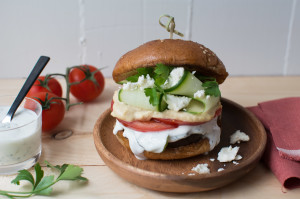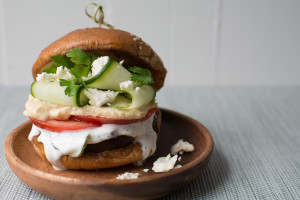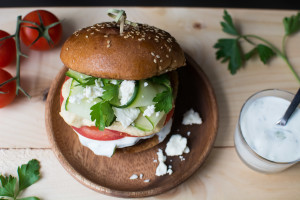 We’ve spent a lot of time outdoors lately, you know, since that 10 feet of snow melted here in Boston. We’ve been grilling multiple times a week, since everything just seems to taste better that way, and the clean-up is so easy. And what is easier meal on the grill than burgers? Nothing. The answer is nothing.
We’ve spent a lot of time outdoors lately, you know, since that 10 feet of snow melted here in Boston. We’ve been grilling multiple times a week, since everything just seems to taste better that way, and the clean-up is so easy. And what is easier meal on the grill than burgers? Nothing. The answer is nothing.
We’ve also planted our vegetable garden, which is a ton of work because the birds that have taken up residence in our barn roof will eat anything that’s small and green. We’ve lived in our apartment for five years, planting a garden every summer. And every summer my tactics to avoid bird-based garden annihilation have gotten more advanced.
Before we planted the garden for the first time, our landlord, Paul, warned us that his father had tried to have a vegetable garden at our house for 20 years, but had never succeeded due to all the wildlife in our area. I figured he had to be exaggerating, since we lived in a city now. Even back in the woods where I grew up, animals never seemed to bother our gardens. Spoiler alert – Paul was right.
 The first summer started with a care-free attitude, excited to be settled in to our new place and to watch my garden grow. No attempts were made to keep the birds out, since I honestly had never seen plant-snatching birds, and didn’t believe they would even care. We hadn’t opened our practice yet, and my husband (then just my boyfriend) was covering other offices until we could afford for him not to. I planned out our business from home, which meant I could take some time to work on the garden here and there. It also meant that, after planting my seedlings, I could clearly see the birds swooping down from the barn and plucking them out, one by one.
The first summer started with a care-free attitude, excited to be settled in to our new place and to watch my garden grow. No attempts were made to keep the birds out, since I honestly had never seen plant-snatching birds, and didn’t believe they would even care. We hadn’t opened our practice yet, and my husband (then just my boyfriend) was covering other offices until we could afford for him not to. I planned out our business from home, which meant I could take some time to work on the garden here and there. It also meant that, after planting my seedlings, I could clearly see the birds swooping down from the barn and plucking them out, one by one.
I yelled at the birds and they flew away, but only to the telephone wires hanging above the garden, taunting me. Have you ever heard the clicking sounds that a starling makes? To me it sounded like laughing – little feathered jerks. I knew I had to step up my game, so I started reading up on how to keep the birds out. I tried CD’s (apparently birds don’t like shiny things), sprayed hot pepper juice on the leaves, and even built scarecrows, but the birds saw right through me. I bought bird netting and covered the whole garden, but forgot to think about how I would get back in to weed and harvest my veggies. I was keeping out the birds, but I was also keeping myself out. I knew there had to be a better way. I am a human being, for Pete’s sake. I have to be smarter than a bird – right?
 So I went on the internet, which birds can’t do… or can they? I made a to-scale drawing of a cage I would construct out of PVC. I ordered the attachment pieces to connect each section of pipe, and then went to the hardware store to have 1″ PVC cut into multiple sections, each five feet long. I bought more bird netting – lots more – and Velcro strips to attach it to the cage I would build. Once the attachment pieces arrived, I grabbed my staple gun (the back of the cage is a fence) and got to work.
So I went on the internet, which birds can’t do… or can they? I made a to-scale drawing of a cage I would construct out of PVC. I ordered the attachment pieces to connect each section of pipe, and then went to the hardware store to have 1″ PVC cut into multiple sections, each five feet long. I bought more bird netting – lots more – and Velcro strips to attach it to the cage I would build. Once the attachment pieces arrived, I grabbed my staple gun (the back of the cage is a fence) and got to work.
The end result was a five foot tall, five food wide, 25 foot long bird-proof cage. It’s reusable, pretty easy to assemble, and, most importantly, bird-proof. The birds still taunt me, but now that I work so much there’s less time for it. Good thing birds can’t use the internet to figure out how to one-up me. Until they do, I win.
Now please enjoy this burger.


- 1 package of Lightlife Quinoa Burgers (4 patties)
- 4 whole wheat sesame seed buns
- 1 tomato, sliced thin
- 1/2 cucumber, sliced into strips with vegetable peeler
- 1/2 cup hummus (or more if desired)
- 1/2 cup tzatziki sauce
- Thinly sliced dill pickles (to taste)
- Parsley for garnish
- Toast buns - set aside.
- Coat burgers with olive oil. Place on hot grill, flipping after 3-4 minutes. Burgers are done when browned on all sides and warm throughout.
- Spread hummus on buns or top of burger. Add tomato, cucumber, pickles, tzatziki and parsley. Serve immediately.

Leave a Reply